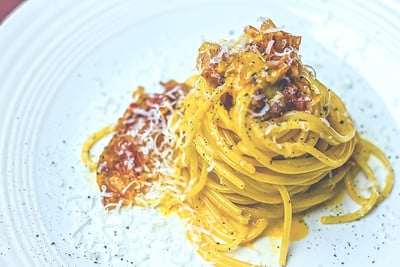Summary
Makes: 16 tuiles
Level: Very easy
Preparation: 13 minutes (including eight minutes cooking)
Tips
Make these on a non-stick baking tray without any sides (as shown above), so that you can just slide them off, without breaking, on to a cooling rack.
Watch them carefully as they need to be just turning a nice golden colour when you remove them from the oven.
These can be made a day or two in advance and kept in a tin.
Ingredients
100g (4oz) Västerbottensost or Parmesan cheese
8 black olives, stones and halved (optional)
Methods
1. Preheat the oven to 200°C (400°F, gas 6, fan 170°C).
2. Line two large baking trays with baking parchment. (Or use two good quality non-stick baking trays.)
3. Divide the mixture into 16 small piles on the baking trays leaving plenty of space for the cheese to spread as it melts.
4. Place half an olive on top of each pile if desired.
5. Bake for between 5 and 10 minutes until golden and the cheese has all melted and is almost set. (I normally find 8 minutes is about right, but ovens do vary so watch carefully.)
6. Allow to cool for a couple of minutes and then slide on to a cooling rack.
7. Serve cold as an aperitif or as a garnish for soups, salads etc.
Cheese and chive tuiles
Mix one tablespoon full of finely chopped chives with the cheese.
Finely chop the deseeded chili and mix with 100g grated cheese. Divide the mixture into 8 oblong mounds on baking parchment. Bake for 5-10 minutes at 150°C (300°F, gas 2, fan 140°C) until the cheese just begins to turn colour. (Note that this a lower temperature than for the recipe for round tuiles above as these are thinner.)
Let the tuiles cool for 1 minute or so and then trim the edges with a knife before the cheese completely solidifies. Once trimmed carefully transfer the tuiles to a cooling rack. These also go very well with broccoli soup.
This recipe was originally published on food writer John Duxbury's Swedish Food website




 Please whitelist us to continue reading.
Please whitelist us to continue reading.